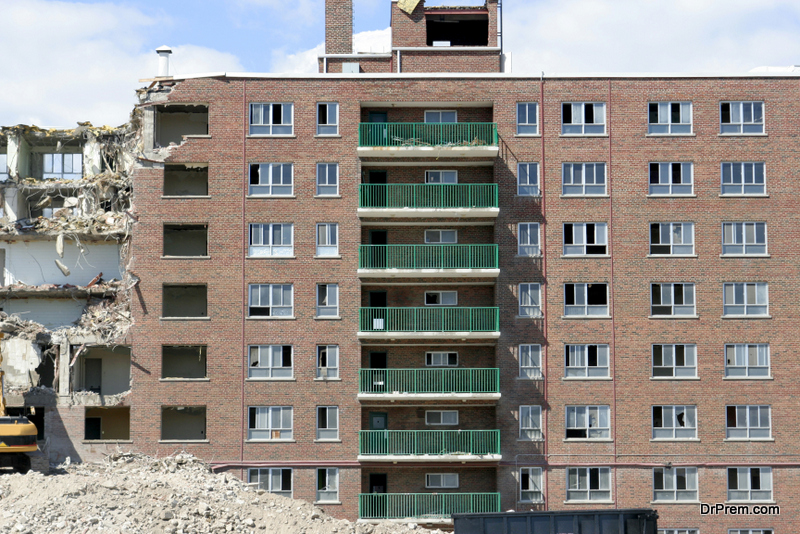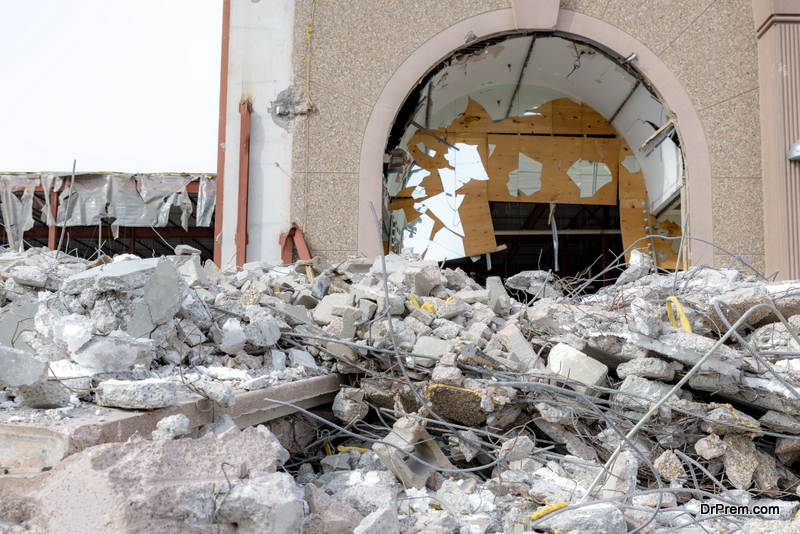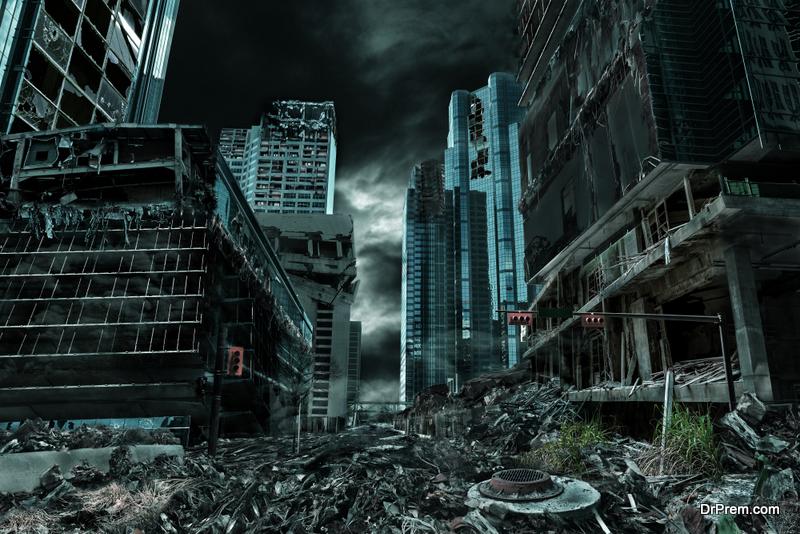When most people think about the destructive nature of earthquakes, what they’re thinking about is fires, overflowing hospitals and emergency services out on the streets. However, most of the destruction during an earthquake is caused by the ground shifting violently and unexpectedly, which then leads to a whole host of other problems: landslides in steep and hilly areas, tsunamis along the coast line and physical cracks in the ground, specifically underneath buildings.
To get an idea of the real impacts of earthquakes in Canada, it’s worth looking at the effects of different magnitude earthquakeson both populated and more rural areas. When discussing the severity of earthquake, it’s common to use the Richter scale which measures the seismic waves caused by a shifting in the earth’s tectonic plates. It’s a logarithmic scale on base 10, so that each level is 10 times more severe than the level before. For example, an 8.0 earthquake is 10,000 times stronger than a 4.0 earthquake – no wonder they cause so much damage!
Less than 3.0
 There are thousands of earthquakes all over the world that register at 3.0 or less on the Richter scale each day. These are simply a result of small shifts between the tectonic plates, and aren’t able to be felt by humans. Indeed, the setting of 3.0 is the cutoff point at which earthquakes (or microquakes as these small tremors are referred to) can’t be sense in other parts of the world. There is no earthquake damage from a microquake, but they can be indicators that a bigger tectonic shift is coming.
There are thousands of earthquakes all over the world that register at 3.0 or less on the Richter scale each day. These are simply a result of small shifts between the tectonic plates, and aren’t able to be felt by humans. Indeed, the setting of 3.0 is the cutoff point at which earthquakes (or microquakes as these small tremors are referred to) can’t be sense in other parts of the world. There is no earthquake damage from a microquake, but they can be indicators that a bigger tectonic shift is coming.
Between 3.0 and 5.5
While these bigger quakes are slightly less frequent than the microquakes, there are still an estimated 30,000 a year – almost 100 per day. You’re likely to feel these as slight tremors, but they tend to be very short in duration and cause people to look up from what they’re doing rather than panicking. They can cause slight damage to objects with loose foundations like tomato cages or pop up tents.
Between 5.5 and 6.0
 You’ll definitely notice one of these if you’re near the epicenter (the location on the crust directly above where the tectonic plates slipped and shifted against each other). The earthquake impact of these will be some slight damage to buildings and other structures. This may include cracks in external brickwork, damage to metal frames as the poles are shifted and glass shattering in greenhouses. These happen once a day around the world, so they’re relatively unlikely to happen in Canada from a statistical point of view.
You’ll definitely notice one of these if you’re near the epicenter (the location on the crust directly above where the tectonic plates slipped and shifted against each other). The earthquake impact of these will be some slight damage to buildings and other structures. This may include cracks in external brickwork, damage to metal frames as the poles are shifted and glass shattering in greenhouses. These happen once a day around the world, so they’re relatively unlikely to happen in Canada from a statistical point of view.
Between 6.1 and 6.9
Anything beyond a 6.0 earthquake is getting to be serious news. In heavily populated areas, earthquakes in the 6 range on the Richter scale can have high levels of destruction. You’re likely to see cracks in the ground and feel the earth undulate underneath your feet. Buildings without strong and deep foundations will suffer the most as the ground can move up to half a meter, causing cracks and breaks in the walls and joints. You’ll also find earthquake aftermath damage such as fires due to electrical shortages and broken water pipes. Expect to be without power, but not for long.
Between 7.0 and 7.9
 Even out in rural areas of Canada, an earthquake in this range is going cause serious damage. Towards the coastline, you can expect to see tsunami warnings and evacuation emergency broadcasts. Further inland, landslides are common, especially in hilly areas or places where the terrain is largely soil and dirt. However, the biggest impact of an earthquake of this magnitude will be seen in built up, urban areas. Here, you’ll see structural damage to taller buildings, and there will be plenty of damage to store fronts, street lighting and outdoor structures, to name just a few. There is the possibility of collapsing buildings and for large ruptures to appear in the ground.
Even out in rural areas of Canada, an earthquake in this range is going cause serious damage. Towards the coastline, you can expect to see tsunami warnings and evacuation emergency broadcasts. Further inland, landslides are common, especially in hilly areas or places where the terrain is largely soil and dirt. However, the biggest impact of an earthquake of this magnitude will be seen in built up, urban areas. Here, you’ll see structural damage to taller buildings, and there will be plenty of damage to store fronts, street lighting and outdoor structures, to name just a few. There is the possibility of collapsing buildings and for large ruptures to appear in the ground.
Above 8.0
Any earthquake that measures above an 8.0 on the Richter scale is likely to become international news due to the incredible scale of the earthquake damage done by a quake of this size. At the epicenter, entire communities could be reduced to rubble, and there is a strong chance of liquefaction; this is where the sediment grains mix with the rising groundwater, making it look and feel like the ground has turned to water. This is the biggest cause of damage in a massive quake as everything that has foundations in the ground suddenly becomes loose and unsecured. It can also cause long lasting chaos as it can break pipes containing power, water and sewage, which can all take an incredibly long time to fix. Fortunately, these monster earthquakes only come along every 5 to 10 years globally, and there have only been two recorded within Canada’s borders since records began.
Staying safe
 In any size earthquake (above a microquake) you need to make sure that you have a sufficient earthquake safety kit and plan ready to go. As can be seen, when the ground starts to move, there’s no way of knowing how big it will be, or what the real impacts of the earthquake will be. Your earthquake safety kit therefore needs the following to meet all possible scenarios:
In any size earthquake (above a microquake) you need to make sure that you have a sufficient earthquake safety kit and plan ready to go. As can be seen, when the ground starts to move, there’s no way of knowing how big it will be, or what the real impacts of the earthquake will be. Your earthquake safety kit therefore needs the following to meet all possible scenarios:
- First aid kit with plenty of spare supplies
- Food and water for three days for all people you expect to be looking after
- Spare clothes, including waterproofs and warm layers
- A flashlight, as well as a set of candles and matches
- A portable radio, preferably with a wind up option
- Battery powered cell phone chargers
Your earthquake safety plan should also include a list of emergency contact information, reliable local news sources and a plan of where to meet in case your home is not a viable option. If you have young children at home, it’s worth talking to them about what would happen in the same tone as you explain a fire drill at school; it’s not likely to happen, but if it does, you need to be prepared and ready to take action to keep everybody safe.
Article Submitted By Community Writer


